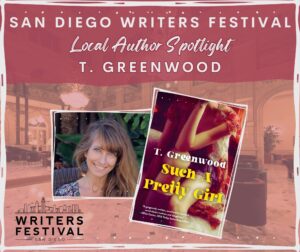T. Greenwood, author of SUCH A PRETTY GIRL, interviewed by Leslie Ferguson, for the San Diego Writers Festival, April 2023:
 1. What inspired your historical novel, SUCH A PRETTY GIRL?
1. What inspired your historical novel, SUCH A PRETTY GIRL?
I grew up in the 1970s and have wanted to write a story about what it was like for girls growing up at that time for a long time. I also distinctly remember the controversy surrounding some of the female actresses of that era: Jodie Foster, Brooke Shields, etc…, and I wanted to write a story about a woman who—in the #metoo era— must look at her unusual childhood through a contemporary lens. And so I chose a former child actress and model, Ryan Flannigan, as the protagonist of my novel. I also knew I wanted to set the story in two very different places, and so the book opens at a summer stock theater community in rural Vermont and moves to an artists community in the West Village in NYC.
2. Can you say a little about your research process for SUCH A PRETTY GIRL?
I did a lot of research about child actors and actresses from this time period. But the bulk of my research was about New York City in the 1970s. It was such a dark time for the city, though my own memories of it are sort of magical. I grew up in Vermont and took several trips into the city in the mid-to-late 1970s, and so I had a bit of a point of reference. However, I have never lived in New York, so I had to read a lot and talk to people who are more familiar than I. Much of the research involved revisiting the cultural touchstones of my own childhood, from Magic 8-balls to Love’s Baby Soft ads, to American Bandstand and the Sears Christmas Wishbook. It was a very nostalgic book for me to write.
3. The cover for SUCH A PRETTY GIRL is provocative in the best way . . . what can you tell us about it and how it came to be?
My publisher sent several possible covers, and I originally picked a different one—one that I thought might be more eye-catching to a prospective reader. But after making that decision, I just had a gnawing feeling in my stomach that I had made the wrong choice, and I wrote a panicked email to my editor telling her I had changed my mind. Fortunately it wasn’t too late. I love how evocative the photo is. And it actually looks like a photo that might have been taken inside Henri’s apartment in Westbeth. The entire novel hinges on a photograph taken of Ryan, and I feel like the jacket art captures the complexity of that photo.
4. How would you describe your writing path over the years?
I have been writing since I was a child and publishing novels for almost 25 years. There have been career highs and career lows, but I have never stopped writing. For me, there is the creative process and there is the publishing industry. The former is almost always joyful, while the other is unpredictable. I try not to allow the fickleness of the business side of things to taint the pleasure I always get from writing.
5. What comes first for you—the plot or the characters—and why?
I generally begin every novel I write with a sort of question. And then I write the book to find the answer. Usually, this looks like a character in a particular situation. So, I guess that means both?
With this novel, the question was “What happens when a problematic photo from a woman’s past resurfaces?” And then I wrote the novel to find out what the photo looked like, who took it, and how it wound up in the hands of a monster.
6. How do you develop your plot and characters?
I keep notebooks, and I brainstorm a lot before I actually sit down to write. I have a fairly intuitive sense of structure and pacing, and characters come as I sit and spend time with them.
I heard a piece of advice once that if you know your plot but don’t have a strong character, simply think of the person who would be the most inept at handling that (plot) problem. Conversely, if you have a vivid character in mind, but no plot, think about what could happen that would challenge that character to change and grow.
7. How have your childhood and your life in general affected your writing in terms of the kinds of stories you choose to develop?
Anaïs Nin said, “We write to taste life twice, in the moment and in retrospection.” I agree. Writing for me is often about revisiting moments in my life, creating a patchwork of my experience. But I also feel that writing—like reading—allows me to live all the lives I have not lived.
8. Is there anything else you’d like to share regarding your work, life, or goals or about what you’re focusing on now?
I am living in a recently empty nest— and I am finding that in this strange new quiet place, I am reading more and thinking more as well. I hope that both will feed my writing. In terms of forthcoming books, my next novel, THE STILL POINT, a book set in the world of a ballet conservatory, will be published in 2024.




